Faizabad was the original capital of the Nawabs. It lies roughly 130 km east of Lucknow on the banks of the Saryu river. You have probably not heard of this name in the context of tourism. We stopped at the place on our way to Ayodhya to see some of the remaining monuments of the Nawab era.

Faizabad – Nawabs of Awadh – Twin City of Ayodhya
As we passed through the city, it looked like any other town in Uttar Pradesh. Narrow busy streets lined with shops on both sides. Cycle rickshaws, pedestrians & two-wheeler drivers compete for the best bit of the road. Hawkers shouting at top of their voice. Old-style shops take you back in time. Just then you pass by some old structure – an arched gateway or an old Haveli. You wonder how this place would have looked in its hay days.
There are two main things to be seen in the city – the tomb of Nawab Shuja-Ud-Daula and his wife who is popularly known as Bahu Begum.
History of Faizabad

Some historians believe that the area that is today called Faizabad was called Saket during the epic era of Ramayana. It is quite possible as Ayodhya is right next door. This was the mythical palace of Dasrath – the father of Lord Rama.
In known history, Saadat Ali Khan was appointed as the Subedar of Awadh in 1722. He was the first one to build the first cantonment here on the banks of the Saryu River. He was the first Naib of Awadh in the Mughal court. The word Nawab comes from Naib. It would later become the title of his dynasty that would rule Awadh till the independence of India in 1947.
In its initial days, Faizabad was known as Bangla – for the huge mad barracks that were built here. How and when it came to be known as Faizabad seems to be lost in history.
Umrao Jaan Ada or Ameeran as the famous courtesan of Awadh was known to have come from Faizabad. She was sold to a Kotha in Lucknow, and that is where she gained her fame. I would say it was Rekha in the film Umrao Jaan who was immortalized here.
Things to see in Faizabad
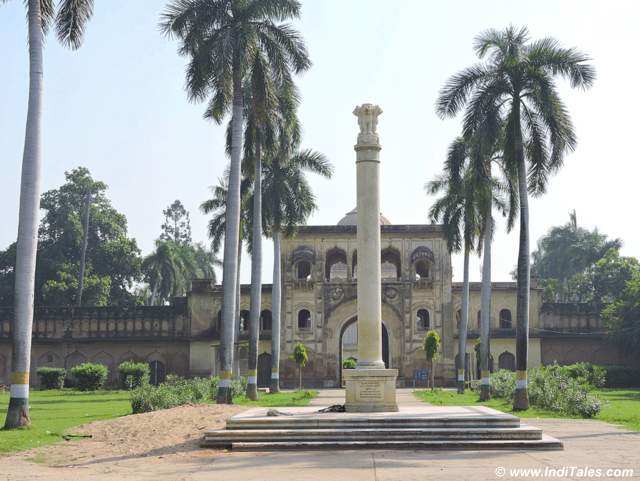
Like any city, you can walk around this one too and know the city. If you do not have time, here are the main places to visit for you.
Gulab Bari – Tomb of Shuja-Ud-Daula

Gulab Bari translates to Rose Garden. However, you do not see any roses around this monument. So, go with your imagination. Try and visualize how this huge campus would look with pink roses blooming all around it.

The first structure that you see is a Nakkar Khana -a gate that was used to play music on its upper story. The gate is in quite a dilapidated state. However, if you look closely at its arches, you would see signs of stucco work and probably some paintings in their faintest version.
We entered through the gate and laid our eyes on the tomb of Nawab Shuja-Ud-Daula. A pillar with lion capital has been installed right at the entry of this – I assume post-independence.
On the right side of the entrance gate is the Imambara and left side is a mosque. Both these structures are kind of inaccessible. All around the tomb the outer wall has simple but lovely turrets, The barracks used to house the staff of the tomb. Today there is a nursery in one part of the garden. This in a way keeps alive the name of the place, though I missed the roses here too.
Tomb of Shuja-Ud-Daula
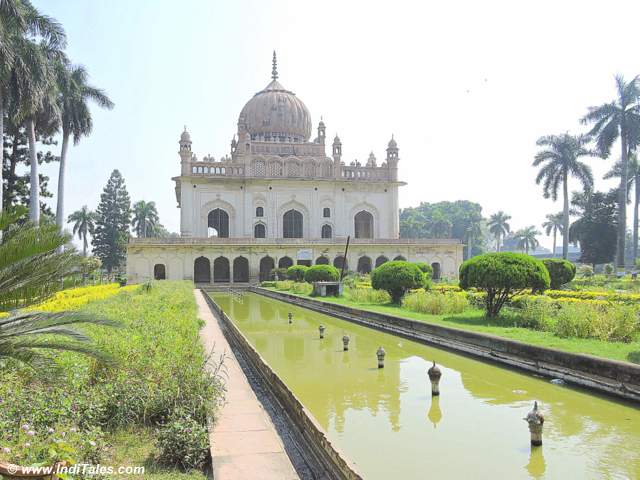
The tomb of Shuja-Ud-Daula follows typical Islamic principles – a grave on the ground floor or basement and a replica of it on the first floor.
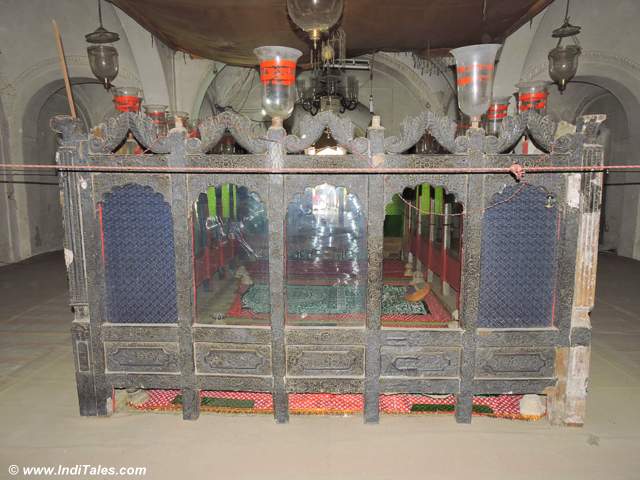
At Gulab Bari, the graves are on the ground floor. You can request the caretaker to open it for you. Shuja-Ud-Daula rests here along with his mother. His father Safdarjung’s grave was also here but it was later shifted to Delhi. In Delhi, his tomb is beautiful in red sandstone comparable to that of Humayun’s Tomb.
Tombs here are built with bricks and covered with thick lime plaster. The Stucco work is influenced by the British. The bricks used are called Lakhori Bricks – they are thinner than the ones we use today.
The grave is simple but it is enclosed in a beautiful wooden perforated wall with arches.
The tomb was built by Shuja-Ud-Daula himself during his lifetime.
Bahu Begum ka Maqbara
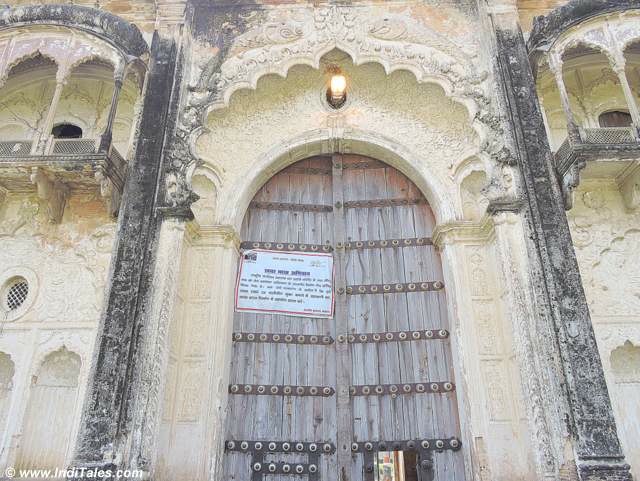
Bahu Begum was the wife of a Shuja-Ud-Daula – Ummataul Zohra. Her tomb is taller than her husband’s tomb and to date, it is the tallest building in the heritage town.
You enter through a lofty gate and get the first view of the tomb through the tree-lined avenue. Take a flight of steps from one corner of the raised platform to reach the upper story. There are halls and corridors that run below the domes.

There are lovely ceiling frescos in pale yellow and bright blue color. They are the best part of this tomb. They look quite recently restored, while most of the other features of the tomb are probably waiting for a restoration. Arches and the stucco work around them make an interesting architecture to admire.
Bahu Begum’s grave is on the ground floor which is inaccessible.
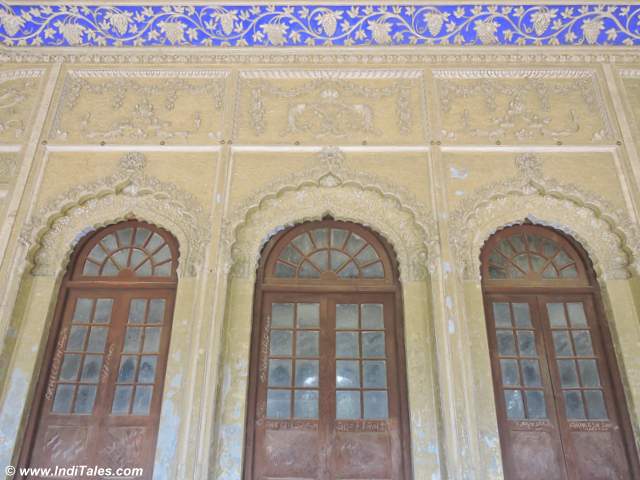
Ostrich Birds
We met a pair of Ostrich in the gardens of Bahu Begum’s tomb. Since not many tourists visit these monuments, they were in attack mode. We had to request the local staff to escort us to the main building. However, this is how I discovered that Ostrich exists in this part of the country. I did not see but I was told that a lot of peacocks live in this complex.

A motif of Twin Fish
A common motif of two fishes can be seen in both tombs. Two fishes are a part of symbols associated with this dynasty. The story goes that when the Nawabs were traveling to build their new kingdom in Lucknow, a pair of fishes came to their boat. They thought of this as an auspicious omen and adopted them as their symbol. Everywhere you go in Awadh, you will be first greeted by the twin fishes.
After spending a couple of hours at these two tombs, we headed to Ayodhya on a boat from the Guptar Ghat. There would be more coming on the Guptar Ghat in the upcoming post on Ayodhya.
While Ayodhya was what I had set out to explore, this place was a chance discovery. It was a great rendezvous with the initial history of the Nawabs of Lucknow.
Recommend you read the following travel blog on places to visit in Uttar Pradesh.
Taj Mahal – the Most Photogenic monument in the world
Fatehpur Sikri – City rooted in Saint’s blessings
The rhythm of chaos on the ghats of Ganga in Varanasi













Everyone like me headed to Ayodhya here but Faizabad is a place where we can visit lot of places . I never know about this. Thank you very much for this post as whenever I will be there , I will visit here for sure .
I think even Ayodhya is hardly visited. Wait for my post on Ayodhya – have to sit & work on it.
Faizabad was a chance discovery for me, I was curious about only Ayodhya.
Stunning. So much rich heritage in Faizabad! And I didn’t even know…
True. It was surprise for me too.
Beautiful! Good to know this. Never really knew about Faizabad’s other beauties before.
Now that you know, when are you planning to go Satyender Ji 🙂
Wow! Nice to know about Faizabad and its monuments.
Are you planning a trip to Faizabad soon now, Niranjan?